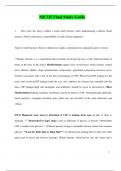Other
NR325 Final Exam Study Guide / NR 325 Final Exam Study Guide (Latest update, ): Chamberlain College of Nursing
Institution
NR325 / NR 325
NR325 Final Exam Study Guide / NR 325 Final Exam Study Guide (Latest update, ): Chamberlain College of Nursing
[Show more]
Preview 4 out of 70 pages
Uploaded on
August 22, 2023
Number of pages
70
Written in
2023/2024
Type
Other
Person
Unknown
All documents for this subject (10)
NR 325 Final Study Guide




